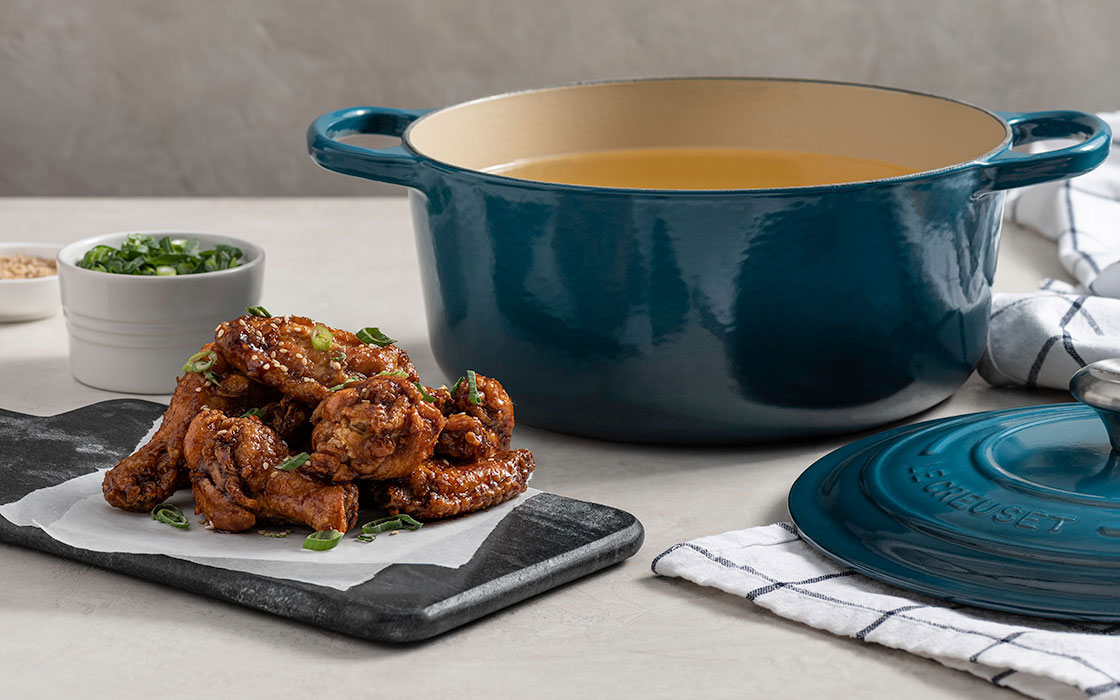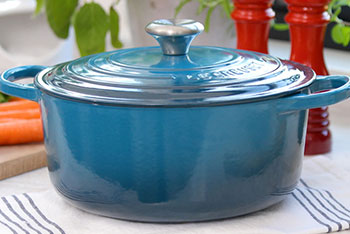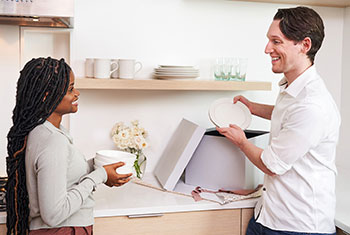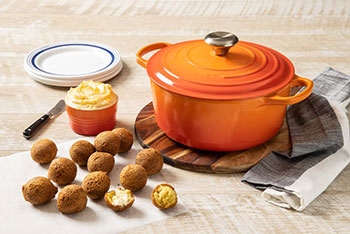There’s no better way to develop savoury flavour and a crisp texture than by frying your food. Frying is a quick-cooking method that uses hot oil to produce a crispy crust with a flavorful, juicy interior. But depending on the food, the recipe may call for either deep frying or pan frying. So what’s the difference?
These methods mostly differ in the pan choice, oil quantities and types of recipes suited to each method. The main difference between them is that when deep frying, the food is completely submerged in hot oil, while in pan frying, the food cooks on one side at a time while in contact with a thin layer of oil. But there are a few other differences to consider, so read on to learn how to fry at home using a Le Creuset Casserole or Skillet.
Deep Frying in a Casserole
Deep frying is the quick-cooking method of choice when you want a crisp, 360-degree exterior. It’s perfect for breaded and battered items like Asian Sticky Wings, Bourbon Brined Fried Chicken, and tempura vegetables. Since the oil is in a deep pot and the food is completely submerged, an extra bonus is limited splattering and little mess when deep frying.
To deep fry like a pro, you need a sturdy vessel with even heat distribution. Le Creuset enamelled cast iron casseroles are ideal for deep frying because the excellent heat distribution and retention of cast iron keep the oil temperature even and consistent, even when adding larger items like bone-in chicken. The light-coloured sand interior allows you to clearly see the colour changes when frying.
Deep frying does require a large quantity of oil with a high smoke point, such as canola, peanut or grapeseed oil. Depending on the recipe, the oil typically needs to be heated to between 160-190°C. The best way to gauge this is with a thermometer. Once the food is done, carefully remove the crunchy results from the hot oil safely without breaking the crispy crust.
Pan Frying in a Skillet
On the other hand, pan frying is best for delicate items like Pan Fried Fish Cakes that would break up if dropped into a pot to deep fry. By cooking in a small amount of oil in a shallow pan, pan frying results in food with two crispy sides and a tender interior, keeping everything intact.
Shallow Skillets and Fry Pans are best for pan frying because the low sides allow a spatula to slip under the cooked side for easy flipping. A shallow pan also allows moisture released by the food as it is cooking to quickly leave the pan. Trapped steam creates a soggy, oil-soaked exterior, so this is crucial to creating that crispy crust we all crave. You can technically fry in any skillet, but just like with deep-frying it works best in a pan with even heat distribution.
An oil with a high smoke point is also key to crispy results, though you will use much less oil than compared to deep frying. Add the oil in an even layer to the pan and heat just until shimmering, not smoking. Add the food and let it cook on the first side until crispy and brown. A thin spatula will allow you to slide gently under the food without breaking the crust. Flip carefully and cook on the other side. To keep splatters to a minimum, simply top the pan with a Splatter Guard while frying.
Frying Tips from our Kitchen
- Choose the right pan—The type of pan you use for frying affects the final results, so make sure to choose the right pan for your method. Deeper and wider Casseroles are best for deep frying, while a shallow skillet or fry pan is ideal for pan frying.
- Use the right oil – Butter or extra virgin olive oil may sound tasty but they will break down and burn at the high temperature needed for frying. Always choose an oil with a high smoke point such as canola, peanut or grapeseed.
- Heat the oil to the correct temperature. Oil that is too hot can burn the exterior before the food has a chance to cook through. And if you end up with oily and soggy food, it’s too cold.
- Choose the right utensils—You don’t want to ruin the crispy crust when you remove the food from the oil. A Wire Skewer or Fry Basket easily lifts perfectly fried food out of a casserole, while a thin metal spatula will ensure success while pan frying.
- Drain excess oil – After frying, let the hot food rest on a wire rack to drain excess oil. Paper towels will hold the oil against the food, making it greasy.
- Don’t overcrowd the pan – Always work in small batches so that the food cooks evenly. Adding too much at once causes the oil and pan to cool down, which can result in a soggy crust.










